Google Ads is one of the most effective online advertising platforms, allowing businesses to reach potential customers precisely when they’re searching for products or services. But before launching a campaign, it’s crucial to understand how much Google Ads might cost. Pricing isn’t fixed; it depends on your industry, competition, target audience, and campaign settings. This guide breaks down how Google Ads pricing works, what influences costs, and how you can estimate and control your budget effectively.
Understanding Google Ads Pricing Models
Google Ads operates on several pricing models, each designed to match different advertising goals. Knowing these models helps advertisers choose the right approach for their campaigns.
Cost-Per-Click (CPC):
CPC is the most common pricing model in Google Ads. Advertisers pay each time someone clicks their ad. Costs vary widely depending on keyword competition, with highly competitive industries such as legal or finance paying significantly more per click than less competitive markets.
Cost-Per-Mille (CPM):
CPM refers to the cost per thousand impressions. In this model, advertisers pay for ad views rather than clicks. It’s often used for brand awareness campaigns where visibility matters more than direct traffic.
Cost-Per-Acquisition (CPA):
CPA pricing charges advertisers when a specific action occurs, such as a purchase or sign-up. It’s goal-focused and can be cost-effective when conversion tracking is properly set up, but requires historical data and optimization.
Key Factors Affecting Google Ads Costs
Several variables determine how much you’ll pay for clicks, impressions, or conversions in Google Ads. Understanding these factors helps you set realistic budgets and improve campaign efficiency.
Industry Competition:
Some industries are more competitive, driving up the average cost per click. For example, legal, insurance, and financial services often see CPCs that far exceed those in retail or home services due to high customer value and intense competition.
Keywords and Their Average CPC:
Each keyword has its own average CPC based on how many advertisers are bidding for it. High-intent, transactional keywords (like “emergency plumber near me”) tend to cost more than informational keywords.
Quality Score:
Google assigns a Quality Score to your keywords based on ad relevance, landing page experience, and expected click-through rate (CTR). A higher Quality Score lowers your actual CPC, improving ad rank at a lower cost.
Ad Rank:
Ad Rank determines your ad’s position on the search results page and is calculated from your bid amount, Quality Score, and expected impact of ad extensions. A better Ad Rank can mean more prominent placement for less money if your ads and landing pages are well-optimized.
Typical Google Ads Costs in 2025
While Google Ads costs vary widely depending on your industry and strategy, some average figures can help set expectations for 2025.
Average CPC Ranges:
In 2025, average CPCs range between $1 and $3 for most industries. However, highly competitive sectors such as legal services, finance, and healthcare can see average CPCs from $6 to $15 or higher. Niche or less competitive industries may pay well below $1 per click.
Average CPM Ranges:
For display campaigns using CPM pricing, costs typically range from $2 to $5 per 1,000 impressions. CPM is generally cheaper than CPC but focuses on brand visibility rather than direct clicks.
Budget Expectations for Small Businesses:
A typical small business might spend anywhere from $500 to $5,000 per month on Google Ads. Actual budgets depend on goals, target locations, and keyword competitiveness. The key is to start with a realistic budget, monitor performance closely, and adjust based on results.
How to Estimate Your Google Ads Budget
Estimating your Google Ads budget involves understanding how your bids, goals, and market conditions interact. Here’s how to approach it effectively.
Setting Daily and Monthly Budgets:
Google Ads allows advertisers to set daily budgets for each campaign. To calculate a monthly budget, multiply your daily budget by 30.4 (the average number of days in a month). For example, a $20 daily budget would equate to about $608 per month.
How Bids Impact Costs:
Your bid determines how much you’re willing to pay for a click or impression, but the actual amount charged can be less due to Google’s auction system. If your competitors bid lower or have poorer Quality Scores, you may pay less while maintaining a strong ad position.
Example Calculations:
If your target keyword’s average CPC is $2 and you aim for 1,000 clicks per month, your estimated budget would be $2,000. Alternatively, if using CPM and targeting 100,000 impressions at $4 CPM, you’d budget around $400.
These estimates should be treated as starting points. Monitoring campaign performance and adjusting based on actual results is essential for cost-efficiency.
Tips to Control and Optimize Google Ads Spend
Effective budget management in Google Ads requires more than just setting limits — optimization is key to ensuring every dollar delivers value.
Targeting Improvements:
Refine your audience targeting by location, device, time of day, and demographics to reach the most relevant users. Avoid wasting budget on irrelevant clicks by excluding low-performing segments.
Quality Score Optimization:
Focus on improving Quality Score by writing relevant ad copy, selecting tightly themed keywords, and creating high-quality, fast-loading landing pages. Higher Quality Scores can significantly reduce your CPC and improve ad placement.
Smart Bidding Strategies:
Use automated bidding strategies like Target CPA or Maximize Conversions to help Google’s algorithm optimize bids for performance. These tools can help control costs while meeting campaign goals, provided you monitor and adjust them regularly.
Conclusion
Understanding Google Ads pricing is essential for running successful, cost-effective campaigns. While costs vary depending on competition, keywords, and campaign strategy, knowing the main pricing models and factors affecting costs empowers advertisers to budget wisely. By setting clear budgets, monitoring performance, and optimizing targeting and Quality Score, businesses can maximize their return on investment and make Google Ads a valuable part of their marketing mix.
